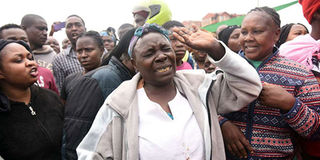Poor state of schools raises concern

Pain grips residents after seven pupils died when a slab caved in at Precious Talents Primary School in Nga'ndo, Dagoretti South, on September 23, 2019. PHOTO | EVANS HABIL | NATION MEDIA GROUP
What you need to know:
- The near-collapse of public primary education in the city has seen the proliferation of private schools, especially in the informal settlements.
- A team recommended that every classroom should be adequately and appropriately equipped to cater for all learners, including those with special needs.
The slab that caved in and killed seven pupils at Precious Talents Academy in Nga'ndo, Dagoretti South, was a disaster waiting to happen.
The school is one among the many throughout the city and countrywide that blatantly violate basic building and safety regulations.
On Monday, the government ordered the audit of infrastructure of all schools in the country.
The review, Deputy President William Ruto said, will ensure that the institutions are habitable.
He said lack of a public primary school in the area had been brought to the attention of the government. “It is sad this has happened. However, the government has set aside Sh10 million to ensure a public primary school is set up soon,” he explained.
Kenya National Union of Teachers Secretary-General Wilson Sossion, who is also a member of the Education Committee, said Parliament had given the Ministry of Education until June to ensure total compliance of minimum national standard of registration by all schools, particularly unauthorised private schools.
“It is a shame that lives of children are at great risk in several unauthorised private schools. For this one, Education Cabinet Secretary George Magoha should take responsibility and resign,” said Mr Sossion in a statement.
REPORT NEGLECTED
Prof Magoha said the school is dully registered and has an enrolment of 800 learners. “We have set up a multi-agency group to work with the Kenya Red Cross to manage the situation. The team will also conduct thorough investigations on the possible causes of the tragedy and submit a report to me for action,” he said
The tragedy, which claimed seven lives, and injured at least 64, also brings to light authorities’ penchant for disregarding informed advice.
That public primary education in Kenya’s capital is in shambles is no secret.
On March 6, 2014, former Nairobi Governor Evans Kidero tasked a team to look into the status of education in the county and make recommendations on how to improve performance of learners in public primary schools.
It was also mandated to generate a draft on an education policy and cost estimates for the proposed Nairobi City County Action Plan.
The multisectoral task force chaired by Dr Mark Matunga visited schools in all wards and submitted its report in July 2014.
That report, like many others, must have gathered enough dust by now for it was never implemented. It is one of the most comprehensive reports on the status of education in the city.
PRIVATE SCHOOLS
The near-collapse of public primary education in the city has seen the proliferation of private schools, especially in the informal settlements, since the government has not built new ones to accommodate the increasing population.
“Although the population in Nairobi is increasing, a few schools have been put up in the recent past. For instance, ECD centres have remained at 21 for more than 15 years,” part of the report reads.
It projected that the population would be 4,253,330 by 2017 and grow at the rate of 11.2 per cent annually.
The task force established that there were only 205 public primary schools in Nairobi serving 193,053 children, yet the primary school-going population was estimated to be 493,586 in 2012 and 596,868 in 2017.
This means that more than half of the eligible population is either in private schools or out of school.
“The majority of these children are likely to be found within non-formal settlements, where provision of basic education remains a big challenge due to limited land for establishing public schools and underdeveloped physical infrastructure in existing schools,” the report reads.
SAFETY
The team recommended that every classroom should be adequately and appropriately equipped to cater for all learners, including those with special needs.
The population in each classroom was pegged at a maximum of 40 learners.
On safety, proper fencing was recommended for all schools as well as provision of security guards to all the public primary and day nursery schools by the county government






